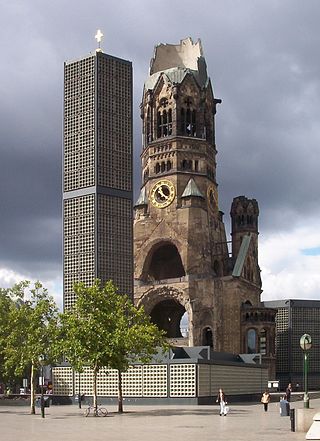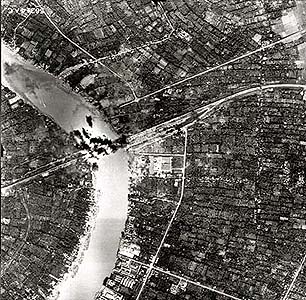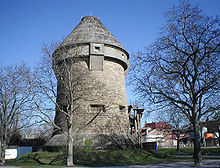
The Allied bombing of Hamburg during World War II included numerous attacks on civilians and civic infrastructure. As a large city and industrial centre, Hamburg's shipyards, U-boat pens, and the Hamburg-Harburg area oil refineries were attacked throughout the war.
The Pathfinders were target-marking squadrons in RAF Bomber Command during World War II. They located and marked targets with flares, at which a main bomber force could aim, increasing the accuracy of their bombing. The Pathfinders were normally the first to receive new blind-bombing aids such as Gee, Oboe and the H2S radar.

Berlin, the capital of Germany, was subject to 363 air raids during the Second World War. It was bombed by the RAF Bomber Command between 1940 and 1945, the United States Army Air Forces' Eighth Air Force between 1943 and 1945, and the French Air Force in 1940 and between 1944 and 1945 as part of the Allied campaign of strategic bombing of Germany. It was also attacked by aircraft of the Red Air Force in 1941 and particularly in 1945, as Soviet forces closed on the city. British bombers dropped 45,517 tons of bombs, while American aircraft dropped 22,090.3 tons. As the bombings continued, more and more people fled the city. By May 1945, 1.7 million people had fled.

The German city of Cologne was bombed in 262 separate air raids by the Allies during World War II, all by the Royal Air Force (RAF). A total of 34,711 long tons (35,268 t) of bombs were dropped on the city, and 20,000 civilians died during the war in Cologne due to aerial bombardments.

During the latter stages of World War II, Pforzheim, a town in southwestern Germany, was bombed several times. The largest raid, one of the most devastating area bombardments of the war, was carried out by the Royal Air Force (RAF) on the evening of February 23, 1945. Some 17,600 people, or 31.4% of the town's population, were killed. About 83% of the town's buildings were destroyed, two-thirds of the complete area of Pforzheim and between 80% and 100% of the inner city.

The city of Würzburg was attacked as part of the strategic bombing campaign in World War II by the Allies against Nazi Germany. Although lacking major armaments industries and hosting around 40 hospitals at the time, Würzburg was targeted as a traffic hub and as part of the attempt by Bomber Command to break the spirit of the German people. The major raid occurred on March 16, 1945, when Royal Air Force bombers dropped incendiary bombs that set fire to much of the city, killing an estimated 5,000 people and almost completely obliterating the historic town. Almost 90% of the buildings were destroyed by a raid that lasted less than 20 minutes.

Prague, the capital and largest city of the German-occupied Protectorate of Bohemia and Moravia, was bombed several times by the Allies during World War II. The first Allied aircraft to fly over Prague was a single bomber of the French Air Force in April 1940, but it dropped propaganda leaflets, not bombs. The first bombing mission was flown by the Royal Air Force (RAF) in October 1941. Prague was then bombed three times by the United States Army Air Forces between the fall of 1944 and spring of 1945. During the Prague uprising of 5–9 May 1945, the Luftwaffe made use of bombers against the rebels.

In the early hours of 15 October 1944, No. 5 Group of the Royal Air Force (RAF) carried out the most destructive of 42 attacks on Braunschweig (Brunswick) during World War II. The attack was a part of Operation Hurricane, which was designed to demonstrate the capabilities of the Allied bombing campaign. It caused a massive conflagration that developed into a firestorm, and resulted in Braunschweig, the city of Henry the Lion, burning continuously for two and a half days from 15 to 17 October. More than 90 percent of the medieval city centre was destroyed.

The Battle of Berlin was a bombing campaign against Berlin by RAF Bomber Command, along with raids on other German cities to keep German defences dispersed and which was a part of the bombing of Berlin during the strategic bombing of Germany in the Second World War. Air Chief Marshal Arthur Harris, Air Officer Commanding-in-Chief (AOC-in-C) Bomber Command, believed that "we can wreck Berlin from end to end if the USAAF come in with us. It will cost us between 400 and 500 aircraft. It will cost Germany the war".
The bombing of Stuttgart in World War II was a series of 53 air raids that formed part of the strategic air offensive of the Allies against Germany. The first bombing occurred on August 25, 1940, and resulted in the destruction of 17 buildings. The city was repeatedly attacked over the next four and one-half years by both the RAF and the 8th Air Force as it had significant industrial capacity and several military bases, and was also a center of rail transportation in southwestern Germany. Stuttgart endured 18 large-scale attacks by the Royal Air Force (RAF) during the war, during which 21,016 long tons (21,353 t) of bombs were dropped on the city, but the RAF concluded that its attacks against Stuttgart were not as effective as they could have been:
Stuttgart's experience was not as severe as other German cities. Its location, spread out in a series of deep valleys, had consistently frustrated the Pathfinders and the shelters dug into the sides of the surrounding hills had saved many lives.

Helsinki, the capital of Finland, was bombed repeatedly during World War II. Between 1939 and 1944, Finland was subjected to a number of bombing campaigns by the Soviet Union. The largest were three raids in February 1944, which have been called The Great Raids Against Helsinki.

Strategic bombing during World War I was principally carried out by the United Kingdom and France for the Entente Powers and Germany for the Central Powers. Most of the belligerents of World War I eventually engaged in some form of strategic bombing. The aerial bombing of cities, intended to destroy the enemy's morale, was introduced by the Germans in the opening days of the war. A multi-national air force to strike at Germany was planned but never materialized.

The city of Bangkok, Thailand was bombed by the Allies on numerous occasions during World War II. It was also the target for the first combat mission by Boeing B-29 Superfortresses in June 1944.

As the main economic and industrial center in Italy, and the country's second largest city, Milan was subjected to heavy bombing during World War II, being the most bombed city in Northern Italy and one of the most bombed cities in the country.

The bombing of Cagliari was a series of attacks by the United States Army Air Force and the Royal Air Force on the Italian city of Cagliari, the regional capital of Sardinia, during World War II. The raids, aimed at destroying the port facilities and airfields of Cagliari, also resulted in the destruction of most of the city.

Owing to its importance as an industrial center, home to Fiat and several other industries engaged in war production, Turin, the regional capital of Piedmont, suffered over a hundred raids by the Allied air forces during World War II; the Piedmontese capital was thus among the most bombed cities in Northern Italy, suffering damage to about 40% of its housing stock, and over 2,000 victims among its population.

During World War II the Italian city of Bologna, the regional capital and largest city of Emilia-Romagna, suffered nearly a hundred air raids by the Royal Air Force and the USAAF, mostly aimed at disabling its strategically important marshalling yards, used for the movements of German troops and supplies between Northeastern Italy and central Italy. These raids destroyed or damaged almost half of the city, and caused nearly 2,500 victims among its population.

Owing to the importance of its port and industries, the Italian port city of Genoa, the regional capital and largest city of Liguria, was heavily bombarded by both Allied air and naval forces during Second World War, suffering heavy damage.

The bombing of Padua was a series of attacks by the United States Army Air Force and the Royal Air Force on the Italian city of Padua, Veneto, during World War II. These raids were aimed at disabling Padua's marshalling yard, but also resulted in heavy damage to the city and civilian casualties.























